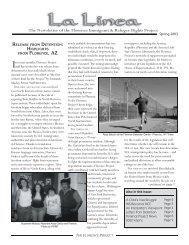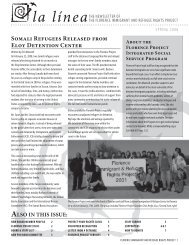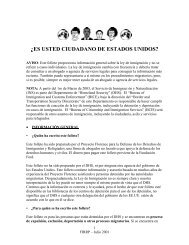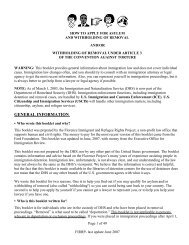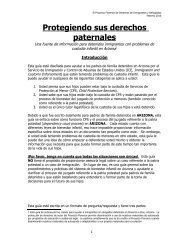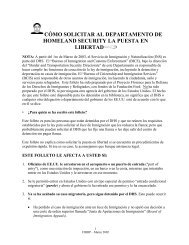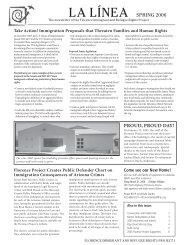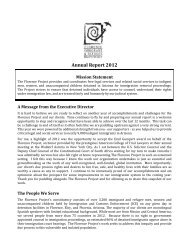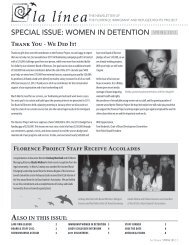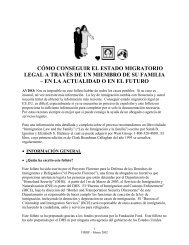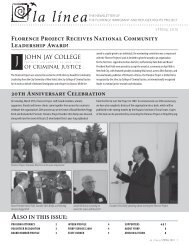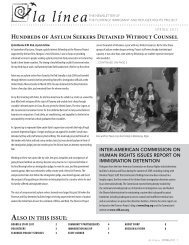quick reference chart and annotations for determining immigration ...
quick reference chart and annotations for determining immigration ...
quick reference chart and annotations for determining immigration ...
Create successful ePaper yourself
Turn your PDF publications into a flip-book with our unique Google optimized e-Paper software.
Immigrant Legal Resource Center, Florence Immigrant <strong>and</strong> Refugee Rights Project,<br />
Maricopa County Public Defender August 2012<br />
documents outside of the record to find that a conviction <strong>for</strong> Shoplifting under § 13-1805 is categorically<br />
a CMT, particularly with pro se respondents. There<strong>for</strong>e, defense counsel should conservatively assume<br />
that a plea in which the intent to deprive is left vague between a permanent <strong>and</strong> temporary taking will be<br />
found a CMT.<br />
Aggravated Felony: Shoplifting will likely be considered an aggravated felony if a sentence to<br />
imprisonment of 365 days or more is imposed. 8 USC § 1101(a)(43)(G). Counsel should avoid a<br />
sentence of 365 days or more. Time imposed under §13-1805(I) as a recidivist sentence enhancement<br />
will be included in this calculation. U.S. v. Rodriguez, 128 S.Ct. 1783 (2008) (overruling U.S. v Corona-<br />
Sanchez, 291 F.3d 1201, 1210 (9th Cir. 2002) (en banc) to find that recidivist sentence enhancements are<br />
given effect). Shoplifting is an aggravated felony “theft” offense because it involves “a taking of property<br />
or an exercise of control over property without consent with the criminal intent to deprive the owner of<br />
rights <strong>and</strong> benefits of ownership, even if such deprivation is less than total or permanent.” Corona-<br />
Sanchez at 1205.<br />
Immigration counsel can argue that a shoplifting conviction does not necessarily involve a<br />
“taking” <strong>for</strong> aggravated felony purposes since transferring merch<strong>and</strong>ise from one container to another or<br />
concealing merch<strong>and</strong>ise would not require the defendant to actually leave the store with the merch<strong>and</strong>ise.<br />
See CMT; Hern<strong>and</strong>ez-Cruz v. Holder, 651 F.3d 1094, 1103 (9th Cir. 2011). However, the argument that<br />
shoplifting is not an aggravated felony may not be as strong as <strong>for</strong> CMTs since a conviction under A4 or<br />
A5 could constitute a “substantial step” such that the offense could be charged as “attempted theft” under<br />
8 USC § 1101(a)(43)(U); Ngaeth v. Mukasey, 545 F.3d 796, 802 (9th Cir. 2008) (entry of a locked vehicle<br />
with an underlying intent to commit theft constitutes a “substantial step” <strong>for</strong> purposes of an aggravated<br />
felony <strong>for</strong> attempted theft).<br />
45. Issuing a Bad Check, ARS § 13-1807<br />
A. A person commits issuing a bad check if the person issues or passes a check knowing that the person<br />
does not have sufficient funds in or on deposit with the bank or other drawee <strong>for</strong> the payment in full of the<br />
check as well as all other checks outst<strong>and</strong>ing at the time of issuance.<br />
B. Any of the following is a defense to prosecution under this section: 1. The payee or holder knows or<br />
has been expressly notified be<strong>for</strong>e the drawing of the check or has reason to believe that the drawer did<br />
not have on deposit or to the drawer's credit with the drawee sufficient funds to ensure payment on its<br />
presentation. 2. The check is postdated <strong>and</strong> sufficient funds are on deposit with the drawee on such later<br />
date <strong>for</strong> the payment in full of the check. 3. Insufficiency of funds results from an adjustment to the<br />
person's account by the credit institution without notice to the person…<br />
D. Except as provided in subsection E of this section, issuing a bad check is a class 1 misdemeanor.<br />
E. Issuing a bad check in an amount of five thous<strong>and</strong> dollars or more is a class 6 felony if the person fails<br />
to pay the full amount of the check, including accrued interest at the rate of twelve per cent per year <strong>and</strong><br />
any other applicable fees pursuant to this chapter, within sixty days after receiving notice pursuant to<br />
section 13-1808.<br />
Summary. While the law is not clear, this is a possible safe plea to avoid moral turpitude <strong>and</strong> the<br />
aggravated felony fraud.<br />
Crime Involving Moral Turpitude: Possibly divisible; counsel should control record of<br />
conviction. Issuing bad checks is a CMT if intent to defraud is an essential element of the crime, either<br />
by specific language or cases interpreting it. See, e.g., Planes v. Holder, 652 F.3d 991, 998 (9th Cir.<br />
2011); Burr v. INS, 350 F.2d 87 (9th Cir. 1965). It is not a CMT if such intent is lacking. See, e.g.,<br />
Arizona Criminal Chart with Explanatory Endnote – August 2012<br />
60



